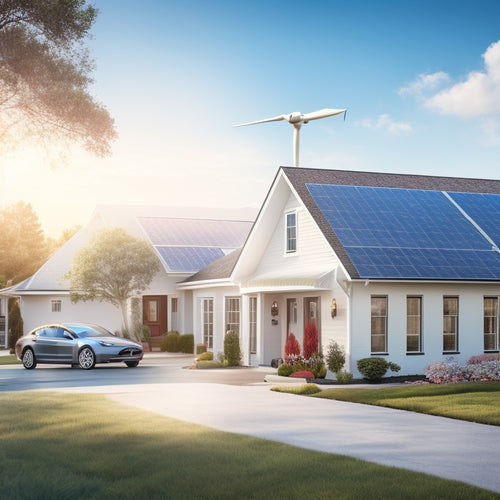
What Expenses Are Included in the Average Cost to Install Solar Panels on a House
Share
When calculating the average cost to install solar panels on your house, you'll encounter a range of expenses, including system design and engineering fees, high-efficiency panel costs, inverter and mounting hardware expenses, labor costs, permits, and roofing and structural analysis. You'll also need to take into account electrical connections, monitoring and tracking systems, battery backup and storage, inspection and testing fees, and warranty and maintenance costs. These expenses can add up quickly, but understanding each component of the installation process will help you make informed decisions and get the most out of your investment - and that's just the beginning of your solar expedition.
Key Takeaways
- The average cost to install solar panels includes system design and engineering expenses, which impact energy efficiency and system capacity.
- Panel costs and quality considerations, including high-efficiency panels, durability, and warranty, affect the overall installation cost.
- Inverter and mounting hardware costs, such as string inverters, microinverters, and power optimizers, are crucial for optimal performance and reliability.
- Installation labor and permits, including application fees and labor rates, contribute significantly to the total installation cost.
- Additional expenses include roofing and structural analysis, electrical connections and wiring, monitoring and tracking systems, battery backup and storage, inspection and testing fees, and warranty and maintenance costs.
System Design and Engineering
When designing a solar panel system, you'll need to take into account several factors to guarantee maximum energy production and cost-effectiveness. You'll want to contemplate the size and layout of your roof, the amount of shade it receives, and the direction it faces. This information will help you determine the ideal system size and configuration for your specific needs.
System performance is vital, as it directly affects energy efficiency. You'll need to assess your energy usage patterns to determine the required system capacity. A well-designed system will ascertain that you generate enough electricity to meet your needs, while also maximizing energy efficiency. This is especially important if you're looking to offset your energy bills or even sell excess energy back to the grid.
A thorough system design will also take into account the type and quality of equipment, including inverters, mounting hardware, and monitoring systems. By carefully selecting and integrating these components, you can guarantee a highly efficient and reliable system that provides years of trouble-free operation.
Panel Costs and Quality
You've carefully designed your solar panel system to maximize energy production and cost-effectiveness. Now, it's time to evaluate the panel costs and quality. The type and quality of solar panels you choose will greatly impact your overall system cost.
High-efficiency panels may come at a higher upfront cost, but they can provide more energy per hour of sunlight, reducing the number of panels needed and increasing your return on investment.
When assessing panel quality, take into account factors like panel efficiency, durability, and warranty. Look for panels with high efficiency ratings, typically above 20%, to guarantee you're getting the most energy from your system.
Also, take into account solar aesthetics, such as the panel's color and frame type, to ensure they blend seamlessly with your roof's design. While high-quality panels may cost more, they can provide longer lifespan, better performance, and increased energy production.
Be certain to research and compare different panel options to find the best fit for your budget and energy needs.
Inverter and Mounting Hardware
As you finalize your solar panel system design, attention turns to the essential components that convert DC power to AC and secure the panels to your roof: the inverter and mounting hardware.
The inverter is an important component that converts the DC power generated by your solar panels into AC power, which is usable in your home. There are several inverter types to choose from, including string inverters, microinverters, and power optimizers. Each type has its pros and cons, and the right choice for you will depend on your specific system design and energy needs.
| Inverter Type | Description | Benefits |
|---|---|---|
| String Inverter | Converts DC power from a series of panels | Cost-effective, easy to install |
| Microinverter | Converts DC power from individual panels | Increased energy production, real-time monitoring |
| Power Optimizer | Optimizes energy production from individual panels | Increased energy production, flexibility in system design |
When it comes to mounting hardware, you'll need a system that securely fastens your solar panels to your roof. There are several mounting systems available, including roof-mounted, ground-mounted, and tracking systems. The right choice will depend on your roof type, local building codes, and energy production goals.
Installation Labor and Permits
You'll need to factor in the costs of permit application fees, which can range from $500 to $2,000, depending on your location and the complexity of the installation.
Additionally, you'll need to pay for the labor costs of the installation team, which typically range from $1,000 to $3,000, depending on the installer's hourly rates and the size of the system.
These labor hourly rates can vary considerably, from $50 to $150 per hour, depending on the installer's experience and the local market.
Permit Application Fees
Obtaining necessary permits is a crucial step in the solar panel installation process, and it comes with associated fees. You'll need to secure permits from your local government and utility company before installing solar panels on your house. These permits guarantee that your solar panel system meets local building codes and solar regulations.
The permit application process can take several weeks to a few months, depending on the complexity of your project and the workload of your local authorities. You'll need to submit detailed plans and specifications of your solar panel system, including the type and quantity of equipment, installation methods, and electrical connections.
Here is a breakdown of typical permit application fees:
| Type of Permit | Average Fee | Application Timeline |
| Building Permit | $500-$1,000 | 2-4 weeks |
| Electrical Permit | $200-$500 | 1-2 weeks |
| Utility Interconnection Permit | $100-$300 | 1-3 weeks |
Keep in mind that these fees and timelines are approximate and may vary depending on your location and the specifics of your project. It's important to factor these costs into your overall budget to guarantee a smooth and successful solar panel installation.
Labor Hourly Rates
About 75% of the total solar panel installation cost goes towards labor, which includes the time spent on installation, permits, and inspections. As you consider installing solar panels on your house, it's crucial to understand the labor hourly rates that factor into the overall cost.
The labor hourly rate for solar panel installation varies depending on the location, company, and technician's skill. On average, you can expect to pay between $75 and $150 per hour for a licensed electrician or solar panel installer. This rate includes the time spent on site assessment, installation, and testing.
Additionally, it covers the cost of labor training, which guarantees that the installers are up-to-date on the latest installation techniques and safety protocols.
The number of hours required for the installation will depend on the complexity of the job, the size of the system, and the type of equipment used. A typical residential solar panel installation can take around 2-5 days, with a team of 2-3 technicians working on the project.
Roofing and Structural Analysis
Before installing solar panels, a thorough roofing and structural analysis is essential to guarantee a safe and efficient installation. You'll want to verify your roof can support the weight of the solar panels, and that the structure can withstand various weather conditions. This analysis will help you identify potential issues before they become major problems, saving you time and money in the long run.
| Analysis Component | Description |
|---|---|
| Roof Condition | Evaluating the condition of your roof, including its age, material, and any damage or wear. |
| Structural Integrity | Examining the strength and stability of your roof's underlying structure, including its framing and support system. |
| Shading Analysis | Identifying potential shading issues from trees, buildings, or other obstructions that could impact solar panel performance. |
| Roof Orientation | Determining the best orientation of your solar panels based on your roof's slope and direction. |
This analysis will also consider local regulations, material choices, and weather considerations to verify your solar panel installation meets all necessary requirements and is customized to your specific needs. By investing time and effort into this critical step, you'll be able to enjoy a hassle-free installation and maximize the benefits of your solar panels.
Electrical Connections and Wiring
When you're installing solar panels, you'll need to connect them to an inverter, which converts DC power to AC power, using specialized panel-to-inverter cables.
These cables must be rated for outdoor use and meet specific electrical standards to guarantee safe and efficient energy transmission.
You'll also need to connect the inverter to your main electrical panel, which may require upgrading your panel to accommodate the additional power source.
Panel-to-Inverter Cables
Your solar panel system's electrical connections and wiring, specifically the panel-to-inverter cables, play a vital role in transmitting power from the solar panels to the inverter, which converts DC power into usable AC electricity for your home or business.
These cables connect the solar panels to the inverter, guaranteeing the efficient transmission of power. You'll typically find two types of cables used for this purpose: MC4 connectors and DC cables. MC4 connectors are industry-standard connectors used to connect solar panels to the inverter, while DC cables are designed to withstand the high-voltage DC power output from the solar panels.
When it comes to installation, it's important to follow proper installation tips to guarantee the cables are secure and protected from environmental factors. Your installer should route the cables in a way that minimizes exposure to UV rays, moisture, and physical damage.
Additionally, the cables should be sized correctly to handle the maximum power output of your solar panel system. Proper installation of panel-to-inverter cables is vital to guarantee the reliability and efficiency of your solar panel system.
Main Electrical Panel
At the heart of your solar panel system's electrical infrastructure lies the main electrical panel, where electrical connections and wiring come together to facilitate the flow of power from the inverter to your home or business.
This vital component is responsible for distributing electricity safely and efficiently throughout your property.
When installing solar panels, you may need to upgrade your main electrical panel to accommodate the new power source. This can involve replacing the existing panel with a newer, higher-capacity model or adding a subpanel to handle the increased electrical load.
- Imagine a sleek, modern panel with ample space for new circuit breakers and wiring
- Visualize the electrical code-compliant connections that guarantee the safe and efficient flow of power
- Envision the increased energy independence that comes with utilizing the power of the sun
Upgrading your main electrical panel can be a significant expense, but it's a key step in guaranteeing the safe and efficient operation of your solar panel system.
Be certain to factor in the cost of panel upgrades when calculating the average cost to install solar panels on your house.
Monitoring and Tracking Systems
Monitoring and tracking systems play an essential role in ensuring your solar panel installation operates at its best level. These systems allow you to monitor your energy consumption and production in real-time, providing beneficial observations into your energy usage patterns.
By tracking your energy consumption, you can identify areas where you can optimize your energy usage, reducing your reliance on the grid and maximizing your savings.
A monitoring and tracking system typically consists of an inverter monitoring system, a data monitoring platform, and a mobile app. The inverter monitoring system tracks the performance metrics of your solar panels, including energy production, voltage, and temperature.
The data monitoring platform aggregates this data, providing you with a thorough view of your energy consumption and production. The mobile app allows you to access this data remotely, receiving alerts and notifications when there are any issues with your system.
With a monitoring and tracking system, you can rest assured that your solar panel installation is operating at peak performance, maximizing your energy savings and reducing your environmental impact.
Battery Backup and Storage
Energy independence takes a significant leap forward with the integration of battery backup and storage systems into your solar panel installation. This added feature allows you to store excess energy generated by your solar panels during the day for use during the night or when the grid is down.
With a battery backup system, you'll enjoy:
-
Uninterrupted power supply: Backup power guarantees your essential appliances remain operational during grid outages, keeping you and your family safe and comfortable.
-
Optimized energy usage: By storing excess energy, you can reduce your reliance on the grid and lower your energy bills, resulting in significant cost savings over time.
-
Enhanced system scalability: Battery technology allows for seamless grid integration, enabling you to expand your system as your energy needs grow.
When choosing a battery backup system, consider factors such as battery lifespan, charging efficiency, and maintenance requirements.
With the right system, you can maximize your energy independence, minimize your environmental impact, and enjoy the peace of mind that comes with having a reliable backup power source.
Inspection and Testing Fees
Before your solar panel installation can be deemed complete, it's necessary to conduct a series of inspections and tests to confirm the system meets local building codes and safety standards.
As the homeowner, you'll want to verify that your solar panel system is installed correctly and functions as intended. To achieve this, your installer will follow a thorough inspection checklist, which includes verifying the electrical connections, confirming proper panel alignment, and checking the system's grounding.
The testing procedures involve simulating real-world scenarios to validate the system's performance. This includes testing the inverter's efficiency, monitoring the system's energy production, and verifying the correct operation of safety features like arc fault protection.
These tests are essential in identifying any potential issues before they become major problems.
You can expect to pay around $500 to $1,000 for these inspection and testing fees, depending on the complexity of your system and local regulations.
While this may seem like an additional expense, it's a significant step in making sure your solar panel system operates safely and efficiently for years to come.
Warranty and Maintenance Costs
With your solar panel system thoroughly inspected and tested, you can now shift your focus to the long-term reliability and performance of your investment.
A detailed warranty and maintenance plan is essential to guarantee your system operates at its best. Warranty coverage typically ranges from 10 to 25 years, depending on the manufacturer and type of equipment. This coverage includes repair costs for faulty parts and labor.
In addition to warranty coverage, you should also take into account maintenance frequency, which may vary depending on your system's size and complexity. Regular inspections can help identify potential issues before they become major problems.
Some key aspects to weigh when evaluating warranty and maintenance costs include:
- Service contracts that outline maintenance schedules and technician qualifications
- Replacement parts and their associated costs
- Performance guarantees that guarantee your system meets expected energy output levels
- Inspection schedules to monitor system performance and identify potential issues early on
Frequently Asked Questions
Can I Install Solar Panels on a Rented Property?
You'll need to check your tenant rights and obtain landlord approval before installing solar panels on a rented property, as modifications to the property require mutual agreement and may impact your lease or rental agreement.
Do Solar Panels Increase or Decrease Property Value?
You'll be happy to know that solar panels typically increase your property worth, making it more attractive to potential buyers, as they're seen as a beneficial, modern solar investment that reduces energy costs and enhances your home's appeal.
Can I Install Solar Panels Myself to Save Money?
You're considering a DIY installation to reap cost savings, but be aware that it's a complex process requiring specialized skills and equipment, and incorrect installation can void warranties and compromise system efficiency.
Are Solar Panels Covered Under Homeowners' Insurance?
You'll be relieved to know that, like the Johnsons, who installed solar panels in California, you're likely covered under your homeowners' insurance, which often includes solar insurance coverage as part of renewable energy policies, protecting your investment.
Can I Finance Solar Panel Installation Through My Utility Company?
You can investigate utility financing options, such as on-bill repayment programs, which allow you to pay for solar panels through your monthly utility bill. Many utility companies also offer solar loan programs with competitive rates, making it easier for you to go solar.
Conclusion
You've made the smart decision to go solar, but now you're wondering what expenses are included in the average cost to install solar panels on your house. Don't worry, we have you taken care of! While the upfront cost may seem challenging, remember that solar panels can increase your property value and save you money in the long run. In fact, according to the US Department of Energy, homeowners who install solar panels can save up to $400 per year on their electricity bills.
Related Posts
-

3 Best State and Local Solar Incentives USA
You can greatly reduce your energy dependence and save thousands of dollars by taking advantage of the top state and ...
-

Why Homeowners Are Embracing DIY Energy Independence
By taking control of your energy needs, you're breaking free from the uncertainty of utility bills and embracing a se...
-

Why Cities Need Smart Charging Infrastructure Now
You're about to experience a tidal wave of electric vehicles hitting your city's streets, and it's essential you're p...


